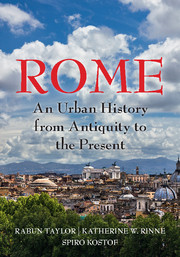Book contents
- Frontmatter
- Dedication
- Epigraph
- Contents
- List of Illustrations
- Acknowledgments
- Map
- INTRODUCTION
- 1 A BEND IN THE RIVER
- 2 A STORYBOOK BEGINNING
- 3 IDEOLOGICAL CROSSFIRE
- 4 BIG MEN ON THE CAMPUS
- 5 RES PUBLICA RESTITUTA
- 6 MEMORIALS IN MOTION: SPECTACLE IN THE CITY
- 7 THE CONCRETE STYLE
- 8 REMAKING ROME'S PUBLIC CORE: I
- 9 REMAKING ROME'S PUBLIC CORE: II
- 10 CRISIS AND CONTINUITY
- 11 RUS IN URBE: A GARDEN CITY
- 12 ADMINISTRATION, INFRASTRUCTURE, AND DISPOSAL OF THE DEAD
- 13 MAPPING, ZONING, AND SEQUESTRATION
- 14 TETRARCHIC AND CONSTANTINIAN ROME
- 15 TROPHIES AND TITULI: CHRISTIAN INFRASTRUCTURE BEFORE CONSTANTINE
- 16 WALLS MAKE CHRISTIANS: FROM FOURTH TO FIFTH CENTURY
- 17 A TALE OF TWO ROMES
- 18 THE ROME OF GOTHS AND BYZANTINES
- 19 CHRISTIAN FOUNDATIONS
- 20 FROM DOMUS LATERANI TO ROMANUM PALATIUM
- 21 THE LEONINE CITY: ST. PETER'S AND THE BORGO
- 22 VIA PAPALIS, THE CHRISTIAN DECUMANUS
- 23 THE URBAN THEATERS OF IMPERIUM AND SPQR
- 24 HOUSING DAILY LIFE
- 25 CHAOS IN THE FORTIFIED CITY
- 26 THE TIBER RIVER
- 27 HUMANIST ROME, ABSOLUTIST ROME (1420–1527)
- 28 PLANNING COUNTER REFORMATION ROME
- 29 PROCESSIONS AND POPULATIONS
- 30 MAGNIFICENT PALACES AND RHETORICAL CHURCHES
- 31 NEOCLASSICAL ROME
- 32 PICTURING ROME
- 33 REVOLUTION AND RISORGIMENTO
- 34 ITALIAN NATIONALISM AND ROMANITÀ
- 35 A CITY TURNED INSIDE OUT
- Glossary of Persons, Places, and Terms
- Works Cited
- Index
20 - FROM DOMUS LATERANI TO ROMANUM PALATIUM
Published online by Cambridge University Press: 05 July 2016
- Frontmatter
- Dedication
- Epigraph
- Contents
- List of Illustrations
- Acknowledgments
- Map
- INTRODUCTION
- 1 A BEND IN THE RIVER
- 2 A STORYBOOK BEGINNING
- 3 IDEOLOGICAL CROSSFIRE
- 4 BIG MEN ON THE CAMPUS
- 5 RES PUBLICA RESTITUTA
- 6 MEMORIALS IN MOTION: SPECTACLE IN THE CITY
- 7 THE CONCRETE STYLE
- 8 REMAKING ROME'S PUBLIC CORE: I
- 9 REMAKING ROME'S PUBLIC CORE: II
- 10 CRISIS AND CONTINUITY
- 11 RUS IN URBE: A GARDEN CITY
- 12 ADMINISTRATION, INFRASTRUCTURE, AND DISPOSAL OF THE DEAD
- 13 MAPPING, ZONING, AND SEQUESTRATION
- 14 TETRARCHIC AND CONSTANTINIAN ROME
- 15 TROPHIES AND TITULI: CHRISTIAN INFRASTRUCTURE BEFORE CONSTANTINE
- 16 WALLS MAKE CHRISTIANS: FROM FOURTH TO FIFTH CENTURY
- 17 A TALE OF TWO ROMES
- 18 THE ROME OF GOTHS AND BYZANTINES
- 19 CHRISTIAN FOUNDATIONS
- 20 FROM DOMUS LATERANI TO ROMANUM PALATIUM
- 21 THE LEONINE CITY: ST. PETER'S AND THE BORGO
- 22 VIA PAPALIS, THE CHRISTIAN DECUMANUS
- 23 THE URBAN THEATERS OF IMPERIUM AND SPQR
- 24 HOUSING DAILY LIFE
- 25 CHAOS IN THE FORTIFIED CITY
- 26 THE TIBER RIVER
- 27 HUMANIST ROME, ABSOLUTIST ROME (1420–1527)
- 28 PLANNING COUNTER REFORMATION ROME
- 29 PROCESSIONS AND POPULATIONS
- 30 MAGNIFICENT PALACES AND RHETORICAL CHURCHES
- 31 NEOCLASSICAL ROME
- 32 PICTURING ROME
- 33 REVOLUTION AND RISORGIMENTO
- 34 ITALIAN NATIONALISM AND ROMANITÀ
- 35 A CITY TURNED INSIDE OUT
- Glossary of Persons, Places, and Terms
- Works Cited
- Index
Summary
IF MEDIEVAL ROME, IN ITS LONG HISTORY, HAD ANYTHING LIKE A MORAL and administrative focus, it was the Lateran palace and the basilica Constantiniana, now called S. Giovanni in Laterano, St. John Lateran, which Constantine, freshly victorious at the Milvian Bridge, built to serve the pope, bishop of Rome. From that moment the fate of medieval Rome was bound to this remote corner of the city, which grew steadily in girth and importance even as the inhabited core contracted away from it. By the ninth century the Lateran complex had become to papal Rome what the Palatine had been to imperial Rome, the supreme seat of administration and political power. Despite ravaging invasions and other adverse conditions, despite the search for alternative seats of papal rule, the Lateran remained inarguably preeminent until the official move to the Vatican in 1420 following the return of the papacy to Rome.
Our investigation into the Lateran's first 1,100 years must be brief, and sadly there is little left to see of this once-magnificent theater of autocratic rule. Other than the baptistery, some adjacent structures, the rebuilt and relocated Triclinio Leonino, and the largely thirteenth-century Sancta Sanctorum, new construction between the sixteenth and nineteenth centuries devoured or covered over nearly the entire medieval scheme. Still, the Lateran was relatively lucky. In an exhaustive study of the physical and literary documents that Rohault de Fleury published in 1877, we have a compelling plan and reconstruction drawing of the complex at the end of the Middle Ages, as it stood in 1300 – the first jubilee year, which drew Giotto and Dante to Rome – pristine and isolated from its environment (Figs. 125, 126).
But because our environmental approach privileges process over the culminating product, our task is to peel back the layers of time so that we can see the matrix of streets, the Aurelian Wall, aqueduct arcades, and other elements that spawned a whole urban quarter we call, by the common Italian term for such a compound, the Lateran Borgo. To aid our reconstructive surgery, Rodolfo Lanciani's Forma Urbis Romae (1893–1901), which shows the modern streets and buildings over the medieval and ancient Lateran neighborhood, is essential (Fig. 127).
- Type
- Chapter
- Information
- RomeAn Urban History from Antiquity to the Present, pp. 188 - 195Publisher: Cambridge University PressPrint publication year: 2016



